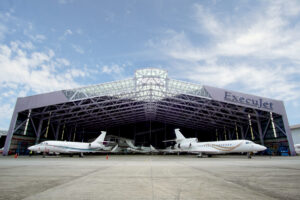Located between two and seven degrees north of the equator, Malaysia is famous for its warm tropical climate, with average temperatures of 23°C to 32°C. Understandably, tourism is a major contributor to the country’s economy, and with summer all year long, there’s no bad time to visit.
Alongside tourism, the country is known for its production of petroleum, palm oil and timber, with its biggest industry being manufacturing.
When it comes to business aviation, Malaysia is carving a place for itself among the region’s heavyweights. While Singapore, Indonesia and the Philippines have the biggest slice of the market, business aviation is growing here and in neighbouring Thailand.
“Malaysia’s central location in Asia Pacific (APAC) is definitely helpful,” says Ivan Lim, Regional vice president Asia at ExecuJet Maintenance, Repair and Operations (MRO) Services. “Plus, being near to some of the region’s financial centres means it’s able to tap into the overflowing traffic from these major hubs.”
As well as its geographic location, the competitive rate Malaysia currently offers due to a lower currency is another factor that’s contributed to its emergence as a business aviation hub, notes Syed Ihsan Syed Idris, general manager of aircraft management services at Sapura Aero.
“It offers cost advantages over regional competitors, serves as an alternative to congested hubs like Singapore, functions as a central hub for regional connectivity, and provides access to emerging markets, all while boasting a well-developed aviation infrastructure,” he points out.
Lim notes that one of the region’s drivers for business aviation was the pandemic. “If you look back, Covid-19 definitely introduced new users to business aviation. Because of the various lockdowns and border closures businesses had no choice but to switch to business aviation in order to meet their travel needs.”
“Malaysia also experienced a surge after the pandemic, with growth in new jet owners, ranging from new and used aircraft purchases, charter services and time-sharing models,” adds Hariss Abdullah, general manager at
Subang SkyPark.
What’s driving growth?

According to Aida Ismail, a member of the Asian Business Aviation Association’s (AsBAA) board of governors, the main areas of business aviation growth are charter demand, the number of jet owners buying the aircraft, and the expansion of MRO facilities.
Things are looking positive for the year ahead, with ExecuJet reporting a 22% growth in hours sold in 2024, which Lim in part attributes to the company’s new facility that was opened last year.
Furthermore, Sapura Aero has forecast an increase in aircraft movements of 10 to 15% in 2025.
This may be in part down to Malaysia’s position as country chair of the Association of Southeast Asian Nations (ASEAN) this year. “We expect there will be lots of movement – especially from the head of states,” says Ismail.
Malaysia’s aviation infrastructure has significantly evolved to accommodate private business aviation, she notes, and today the country has several business aviation centres (BACs). These are Kuala Lumpur International Airport (KLIA), which has a business centre on the mezzanine level for business aviation, Senai International Airport, which features the Senai Business Aviation Terminal (SBAT) and Sultan Abdul Aziz Shah Airport (Subang SkyPark), home to the SkyPark Business Aviation Centre.
While not considered dedicated BACs, Kota Kinabalu and Kuching International Airports also have fix-based operators (FBOs), while Penang and Langkawi are also emerging as prominent business aviation destinations says Ethan Levy, CEO at Tidal Jets.
“They’re attracting high-end leisure travelers and corporate executives due to their expanding manufacturing sectors and corporate offices.”
Subang is the most prominent business aviation hub in the country and home to the SkyPark Business Aviation Centre (SBAC). For many years it was the country’s main international airport for general aviation, with its focus on business aviation coming to the forefront after the opening of KLIA.
“When you talk about business aviation in Malaysia, you are really talking about Subang,” says Lim. “This is because over the years it’s where business aviation in the country has been concentrated.”
According to those in the industry, if you compare it to other airports in the APAC region, one of its key benefits is ease of operation.
“It’s open 24/7, 365 days a year, has attractive fuel prices and there is 24 hour support from SkyPark FBO for permits and handling,” says Abdullah.
In recent years, the airport has also been central to broader initiatives — such as the Subang Airport Regeneration Plan — to enhance its status as a regional business aviation hub.
This was announced in 2023, with Phase one taking place between 2024 and 2027 and Phase two from 2032 to 2035. This initiative aims to transform Subang SkyPark into a major business hub with upgraded facilities and services. Significant investments are being made in infrastructure, with a projected cost of RM1.3 million (US$293K). This will include an expansion of the terminal, new dedicated parking aprons and airside facilities, all aimed at enhancing capacity and operational efficiency, and targeting an increase in passenger handling from three to five million a year.
“The plan includes replacing aging hangars with modern, leasable ones and ensuring comprehensive support services, such as ground handling and transport are in place,” says Lim.
“It’ll be a complete ecosystem, with plans to introduce additional office space to accommodate for other players in the industry, such as aircraft management companies or charter firms,” he continues. “There’s no reason why an aircraft or operator would fly into Subang and feel like there’s something missing. It will be on par with the more advanced or mature markets like Europe or America.”
Future plans involve integrating KLIA and Subang’s operations to avoid service overlap while maximizing efficiency across different types of aviation services.
Government support
The Malaysian government is behind the Subang regeneration plan, positioning it as a central node in Malaysia’s aerospace ecosystem that will provide MRO activities for various types of aircraft including business jets.
This focus on developing a comprehensive aerospace ecosystem is designed to attract foreign investment and create high value jobs within the sector.
“One thing we really appreciate is that aviation, and the wider aerospace industry more generally, is recognized as a key driver by the Malaysian government. We see it regularly considered in plans and policies, and it’s great to have that level of support,” says Lim.
The Civil Aviation Authority of Malaysia (CAAM) is also enhancing regulatory frameworks to support the growth of business aviation, ensuring that operational flexibility and infrastructure development keep pace with industry needs.
Challenges and opportunities

But while this all sounds positive, there are some regulatory and bureaucratic challenges the industry faces, notes Idris.
“These include landing and overflight permits, cabotage rules, aircraft registration processes and customs and immigration procedures.
“Business jet operators must obtain permits for landings and overflights, often requiring lead times of 48-72 hours, which can be restrictive for short-notice flights. Secondly, Malaysia restricts foreign-registered business jets from operating domestic flights, limiting flexibility for international operators,” he explains.
“Registering an aircraft under the Malaysian Aircraft Registry can be complex due to stringent CAAM compliance requirements. Plus, while Malaysia has dedicated BACs, delays in customers and immigration clearance can still occur, especially outside peak operating hours.”
Ismail notes however, that changes are underway that may lessen these issues. “The Malaysian Aviation Commission’s objectives, powers and functions are being transferred to CAAM, making it the sole regulatory body for civil aviation in Malaysia in an effort to reduce bureaucracy and improve the efficiency of licensing services,” she explains.
Aircraft maintenance delays, stemming from supply chain issues affecting availability of parts and MRO turnaround times, pose another significant challenge. For Lim the biggest concern is a shortage of skills. He finds that there aren’t enough skilled maintenance technicians and engineers to meet demand.
Thankfully he has seen a renewed focus from government to put more attention on technical or vocational skills in schools and universities, but the results of this work may not be seen for some time. Rather than solely relying on the government to fix this issue, the industry is also taking its own steps to create a skill pipeline.
“We invest quite a lot into the training of our personnel, enabling them to become internationally certified maintenance technicians and engineers and keep them up to date with the new aircraft types as they enter the market,” says Lim. “We’re also looking to address this matter by coming up with our own apprenticeship program where we take students on after school and train them up.”
With the Subang Regeneration Plan underway, an increasing demand for charter aircraft and support from the government, many in Malaysia are confident that the future of business aviation here is very positive, with continued growth expected.
“Infrastructure projects, such as the expansion of Kota Kinabalu International Airport, will support this growth,” notes Levy.
“Rising demand, particularly in the business and luxury travel sectors, coupled with ongoing investments in infrastructure and streamlined operations, could position Malaysia to attract more private aviation traffic and better compete with regional hubs,” he concludes.





